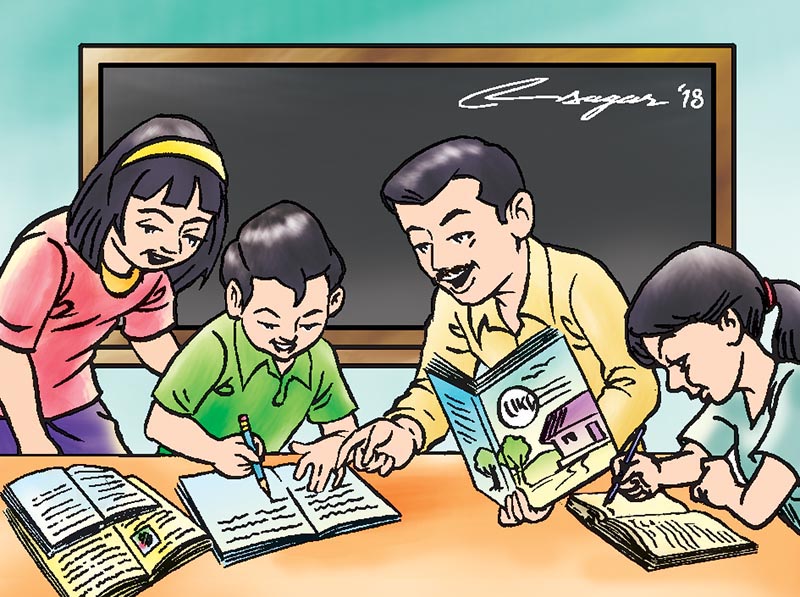Empathy in classroom: Educators must close the gap
Encouraging students to ask questions and creating an environment for them to share their problems without any fear of being judged can liberate students’ thought and encourage them to be creative
Compassion is a natural tendency and it is essential for human survival. It establishes a strong bond between two individuals. As we are likely to get inclined towards love and care, students are no exception. They desire to have an understanding relationship with their teachers, but a gap is created when their teachers fail to establish a strong, compassionate and understanding-based relationship with their students. Teachers impart knowledge to their students but at times they fail to create an environment where students can learn without fear.
There is a beautiful poem by the great Rabindranath Tagore, in which he says” “When the mind is without fear… into that heaven of freedom, my Father, let my country awake.” Whether it is about citizens of a country or students of a school, it is essential that the mind is without fear. A fearful mind blocks the learning and understanding capacity of students. As a result, performance of students decelerates. In order to boost their learning capacity and performance, the mind needs to be without fear.Students spend substantial time with their teachers in school and acquire knowledge, but unfortunately, majority of students struggle to deal when their mind is engulfed by fear. Teachers can a crucial role in shape their students just like potters shape a lump of clay into different vessels.
A potter can create the finest of pots out of a lump of clay if it is made with proper love and care. Every finest product in the world is an outcome of emancipated mind and compassion. Similarly, teachers’ approach towards developing empathy for their students can have a positive impact on the lives of students. Teachers’ one step taken towards creating a comfortable environment for students to share their problems and views can result in maximum development of students’ mental capacity and improvement in their overall performance.
Oftentimes teachers tend to use their anger as a tool to control their students and maintain discipline in the classroom. Empathy can rather be used as a tool in establishing discipline and supporting students in constructive development of students. Encouraging students to ask questions and creating an environment for them to share their problems without any fear of being judged can liberate students’ thought, encouraging them to be creative. A cooperative teaching-learning process in classrooms helps bring out the best of students. Teachers’ concerned effort towards creating absence of fear in their students’ mind can help to bridge wide empathy gap between students and teachers.
Empathy plays a vital role in establishing strong association between two individuals as it creates a space to feel the pain and suffering of others. It is understood as putting oneself in the shoes of others to feel their pain and sufferings.
One thing teachers should never use in classrooms is corporal punishment. Punishing students can instill fear in student’s mind, which could encourage bias and prejudice in students. This ultimately could create a huge empathy gap between teachers and students. If we can bridge the empathy gap between teachers and students, it will not only strengthen their relation but also enhance the teaching-learning process effectively. Increasing students’ participation in the classrooms and providing them a platform to share their ideas, thoughts and problems without any hesitation and fear are quite helpful in bridging the empathy gap between teachers and students.
Fear is an unsettling emotion that is constructed by society within a human being. In an attempt to shape a child’s future, parents, society and teachers at times unintentionally weaken their actual learning capacity, as they tend to create an atmosphere of fear to maintain discipline. Such trend of dealing with students has unfortunately forced many students to go through psychological trauma, frustration and depression.
The World Health Day 2017 strongly led a campaign on mental health care. In order to give sustainability to it, it is essential that an atmosphere is created at psychological level where students can trust their teachers and feel comfortable to share problems with them. A healthy and comfortable relationship between students and teachers can only be established if teachers avoid chiding and punishing students repeatedly. Instead they should deal with their students with compassion.
“Teachers should be friendly with students but not friends”, it is said. But are all teachers really friendly with students? If teachers become friendly with students, it will automatically reduce fear, trust deficit and hesitation in students, thereby bridging empathy gap between teachers and students. Once teachers start dealing with students in a friendly and compassionate manner, it will create a comfortable atmosphere where both students and teachers can share their ideas and stories. Considering student’s perspective can hugely help improve teacher-student relationships.
Identifying students’ problems, weakness and strengths at personal level can help teachers to develop good understanding with their students. Ultimately, a strong empathy between students and teachers would provide direction to students’ future and achieve satisfaction in teachers’ life. What students achieve in their late lives is ultimately an achievement for the teachers who helped them shape their future through compassion and empathy.






